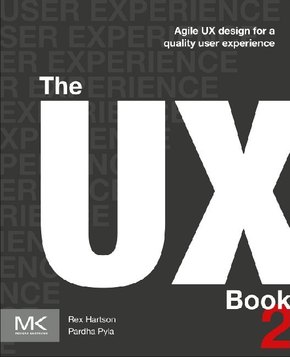The UX Book - Agile UX Design for a Quality User Experience
| Verlag | Morgan Kaufmann |
| Auflage | 2019 |
| Format | 19,1 x 23,6 x 4,4 cm |
| Gewicht | 1840 g |
| Artikeltyp | Englisches Buch |
| EAN | 9780128053423 |
| Bestell-Nr | 12805342EA |
The discipline of user experience (UX) design has matured into a confident practice and this edition reflects, and in some areas accelerates, that evolution. Technically this is the second edition of The UX Book, but so much of it is new, it is more like a sequel.
One of the major positive trends in UX is the continued emphasis on design-a kind of design that highlights the designer's creative skills and insights and embodies a synthesis of technology with usability, usefulness, aesthetics, and meaningfulness to the user. In this edition a new conceptual top-down design framework is introduced to help readers with this evolution.
This entire edition is oriented toward an agile UX lifecycle process, explained in the funnel model of agile UX, as a better match to the now de facto standard agile approach to software engineering. To reflect these trends, even the subtitle of the book is changed to "Agile UX design for a quality user experience?.
Desig ned as a how-to-do-it handbook and field guide for UX professionals and a textbook for aspiring students, the book is accompanied by in-class exercises and team projects.
The approach is practical rather than formal or theoretical. The primary goal is still to imbue an understanding of what a good user experience is and how to achieve it. To better serve this, processes, methods, and techniques are introduced early to establish process-related concepts as context for discussion in later chapters.
Inhaltsverzeichnis:
PART 1. INTRODUCTION
1. What is UX and UX design?
2. The Wheel: UX processes, lifecycles, methods, and technique
3. Scope, rigor, complexity, and project perspectives
4. Agile lifecycle processes and the Funnel Model of Agile UX
5. Prelude to the process chapters
6. Background: Introduction
PART 2. UNDERSTAND NEEDS
7. Usage research data elicitation
8. Usage research data analysis
9. Usage research data modeling
10. UX design requirements: User stories and requirements
11. Background: Understand Needs
PART 3. DESIGN SOLUTIONS
12. The nature of UX design
13. Bottom-up vs. top-down design
14. Generative design: Ideation, sketching, and critiquing
15. Mental models and conceptual design
16. Designing the ecology and a pervasive information architecture
17. Designing the interaction
18. Designing for emotional impact
19. Background: Design
PART 4. PROTOTYPE CANDIDATES
20. Prototyping
PART 5 . EVALUATE UX
21. UX evaluation methods and techniques
22. UX evaluation: UX goals, metrics, and targets
23. Preparation for empirical UX evaluation
24. Empirical data collection methods and techniques
25. Analytical data collection methods and techniques
26. UX Evaluation: Data analysis
27. UX evaluation: Reporting results
28. Background: UX evaluation
PART 6. AGILE UX AND CONNECTIONS TO AGILE SE
29. Connecting agile UX with agile software development
30. Background: Agile connections
PART 7. AFFORDANCES AND DESIGN GUIDELINES
31. Affordances in UX design
32. The interaction cycle
33. UX design guidelines
34. Background: Affordances and UX design principles

